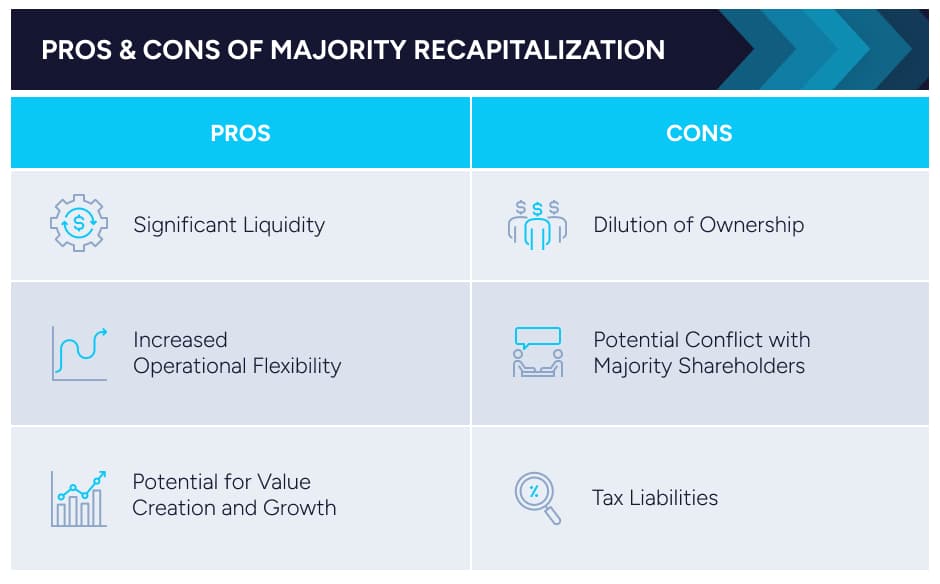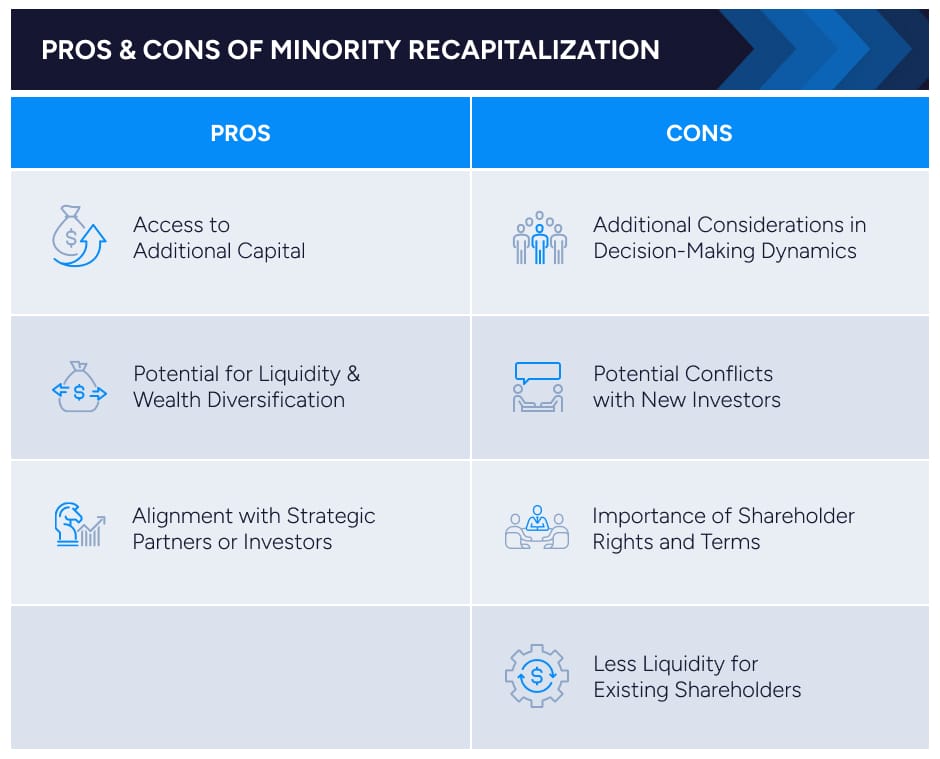Recapitalization 101: The Key to Unlocking Your SaaS Business’s Growth Potential

In the fast-paced world of software and SaaS companies, financial strategies that promote growth, innovation, and adaptability are essential for long-term success. One such strategy is recapitalization, also known as a “recap.” For private software companies, recapitalization can be a powerful tool, enabling them to optimize their financial position and navigate evolving market dynamics while achieving shareholder liquidity. Despite the potential advantages, though, there are many aspects to consider. It is essential that shareholders and leaders carefully analyze both the pros and cons before undertaking any kind of recapitalization.
In this post, we will closely examine recapitalization and explore its crucial role in financial restructuring for private software companies.
What is Recapitalization?
Recapitalization is a process of restructuring a company’s debt and equity mix, also known as its capital structure. There are several reasons that a company might consider recapitalization, such as improving financial stability, reducing the cost of capital, freeing up cash for new investment, providing shareholder liquidity, and updating the investor group to bring new perspectives and skills to the board.
Recapitalization can be accomplished in several ways — for example, by issuing new shares, buying back existing shares, changing the terms of existing debt, or selling a portion of the business, the last of which will be our primary focus.
Equity Recapitalization
Among private software companies, a common way to recapitalize is to sell a portion of the business to another entity, such as a private equity firm or a strategic partner, in a process known as equity recapitalization. In practice, this often involves issuing new shares of common or preferred stock to raise additional capital and may involve existing shareholders selling their shares. Done strategically, companies can use equity recapitalization to position themselves for sustainable growth, partner with strategic investors who can help add value to operations, or pave the way for a full or partial exit from the business.
Recapitalization can also benefit founders and early investors, who often have a sizable portion of their personal wealth tied up in the company. By selling a stake in the business, they can generate cash to diversify their investment portfolio, pursue personal financial goals, or reinvest in new ventures.
Selling a portion of the business also means giving up some control and share in future liquidity events, however. It is important that founders understand the costs and benefits of equity recap and find a partner aligned with their vision for the company.
Majority Recapitalization vs. Minority Recapitalization
In a majority recap, also known as a majority acquisition, the company sells a majority interest (more than 50%) in the company, most commonly to a private equity or growth equity investor. This allows the existing shareholders to realize a large amount of liquidity while also having the option to retain some equity in the company for future upside. In many cases, existing leadership will remain actively involved with the company. In others, they may step into different roles or exit completely.
In a minority recapitalization, on the other hand, existing shareholders sell a stake in the business worth less than 50%. In this scenario, equity can be recapitalized in many ways. Still, the common theme is that since the new investors are not majority shareholders, there is no change in the control dynamics of the business. Whether there is or is not a shareholder in the Company with more than 50% ownership before the recapitalization, the new investor does not hold a greater than 50% share. In a minority recapitalization, existing shareholders see less dilution in their ownership percentage than in a majority recap, but they also see less liquidity and impactful investment into the business. Both involve bringing in strategic investors who can provide expertise, resources, and market access to drive the company’s growth.
While the main goal of a majority recapitalization is shareholder liquidity, the primary goal of a minority recapitalization is obtaining funds to further grow the enterprise value of the business, so there are fundamentally different considerations for shareholders between the two. The decision to go with a majority recapitalization over a minority one depends on the shareholders’ objectives and how much control they are willing to relinquish in exchange for financial resources and liquidity.
Majority Recapitalization: Pros and Cons

Pros of Majority Recapitalization
The decision to pursue majority recapitalization requires careful consideration of its benefits and drawbacks. For founders and existing shareholders, the benefits of private equity recapitalization include:
- Significant Liquidity: A majority acquisition gives founders the opportunity to cash out a large part of their equity in the company while still being able to take advantage of future growth.
- Increased Operational Flexibility: Majority recapitalization can give companies the capital they need to invest in new technologies, enter new markets, and make strategic business decisions that can drive growth.
- Potential for Value Creation and Growth: By bringing in additional capital, majority recapitalization can fuel business growth, increase the company’s market share, and create additional value for shareholders.
Cons of Majority Recapitalization
Though a majority recap provides advantages, it may not be the best option for founders or shareholders who wish to maintain a controlling stake in the company. Here are a few potential drawbacks to keep in mind:
- Dilution of Ownership: By selling a majority stake, existing shareholders dilute their share of the company’s equity into a minority position (or sell entirely), weakening their influence over decision-making.
- Potential Conflict with Majority Shareholders: The new majority stakeholders may have different strategic visions, operational preferences, or return expectations, which could lead to conflicts. This is why finding the right partners is essential.
- Tax Liabilities: Restructuring a company’s capital can trigger capital gains tax and other tax consequences for both the Company and its individual shareholders. Taxes are an especially important consideration if the recapitalization is setting up the business for a future sale. To best establish advantageous tax positions in the event of a majority recap, it is paramount to leverage strong M&A lawyers, accountants, and advisors to assist in decision-making.
Minority Recapitalization: Pros and Cons

Pros of Minority Recapitalization
Minority recapitalization, of course, has its own set of benefits and drawbacks. Some of the benefits for owners include:
- Access to Additional Capital: Minority recapitalization provides fresh capital that can be used for growth initiatives, technological upgrades, and expansion into new markets.
- Potential for Liquidity and Wealth Diversification: Having a large amount of personal capital tied up in a business is risky. By selling part of the business, owners can realize cash that they can then invest outside of the company, even if to a lesser extent than in a majority recapitalization.
- Alignment with Strategic Partners or Investors: New investors can bring valuable expertise, resources, and networks to the boardroom that help drive growth and innovation.
Cons of Minority Recapitalization
Minority acquisition also has its drawbacks, especially when the goals and vision of the original owners are not aligned with those of the new partners. Disadvantages include:
- Additional Considerations in Decision-Making Dynamics: By retaining a majority stake in the business, the existing controlling shareholders retain control of the company’s direction. However, introducing new investors often means pressure to accommodate their ideas or strategies, creating an added dynamic of influence and potential pressure when considering key decisions.
- Potential Conflicts with New Investors: Bringing in new investors can potentially lead to conflicts, especially if their strategic visions or expectations are not aligned with those of the existing shareholders. This places a strong emphasis on bringing in investors who can add value.
- Importance of Shareholder Rights and Terms: It is not uncommon for the new investors’ minority stake to come with certain rights and privileges, such as a board seat, veto rights on certain transactions, or the ability to appoint key executives. These rights, known as protective provisions, can significantly limit the original owner’s control over operational matters.
- Less Liquidity for Existing Shareholders: A minority recapitalization provides less liquidity, or potentially none, for existing shareholders, depending on which shareholder(s) are selling equity, how much new equity is being raised, and how much of the funds are dedicated to achieving business objectives. The goal of minority recapitalizations is often not shareholder liquidity but rather growth and scale, so if that is an important consideration for shareholders, a minority recap may not be the best option.
Debt Recapitalization
In contrast to equity recapitalization, debt recapitalization focuses on reshaping a company’s existing debt obligations. This involves various strategies, such as refinancing existing debt at lower interest rates, extending the maturity of existing debt, or renegotiating the terms of debt agreements. It can also include bringing in a fresh loan and paying off an existing loan, whether due to the cost of capital, debt covenants, or reaching the maturity of a loan. The overarching goal is to minimize interest expenses, improve cash flow, and reduce financial distress by optimizing the company’s debt structure.
In the software industry, debt recapitalization can be a particularly useful tool. It allows companies to manage their debt load more effectively, freeing up resources to invest in innovation and product development. It also is typically non-dilutive, meaning that no equity is traded to receive funds for the business, though there are debt instruments that can be turned into equity, so the details and terms remain critically important.
Factors to Consider in Recapitalization
When considering whether to undertake a recapitalization, SaaS companies need to take several critical factors into account:
- The Company’s Financial Position and Objectives: It is crucial that the recapitalization strategy aligns with the company’s financial goals and needs. It should address any financial constraints the company might face and provide a solid foundation for future growth and profitability.
- Regulatory and Legal Considerations: Companies need to comply with all relevant regulations related to the issuance of new securities and/or the restructuring of debt. This might involve filing appropriate paperwork, seeking approvals, or maintaining specific financial ratios. Legal counsel can provide invaluable assistance in ensuring all regulatory and legal requirements are met.
- Impact on Existing Shareholders and Stakeholders: Issuing new shares or restructuring debt can dilute ownership stakes or change the company’s financial risk profile and operating/reporting requirements. It is crucial to consider the potential impacts and to communicate effectively with shareholders about the recapitalization process and its implications.
- Valuation and Operating Considerations: Finally, recapitalization can have significant implications for the company’s valuation and the pricing of its equity. Executives should consider how changes to the capital structure will affect the company’s valuation at a raise compared to how the existing shares are valued. Financial impacts, such as cost of capital, cash flow, and leverage ratio, as well as qualitative impacts, such as the market’s perception of the company based on financing dynamics and the introduction of specific partners.
Role of M&A Advisors in Recapitalization
The decision to pursue recapitalization is significant with far-reaching implications, not just for your company’s long-term success but also for your personal financial well-being. Professional M&A advisors, such as Software Equity Group, bring a wealth of knowledge, experience, and industry insights to the table. We can provide invaluable guidance in evaluating your company’s financial position, assessing strategic options, advising on a majority recapitalization transaction, and navigating complexities.
If you have questions on how a majority recapitalization could benefit your B2B software company, let’s talk.










